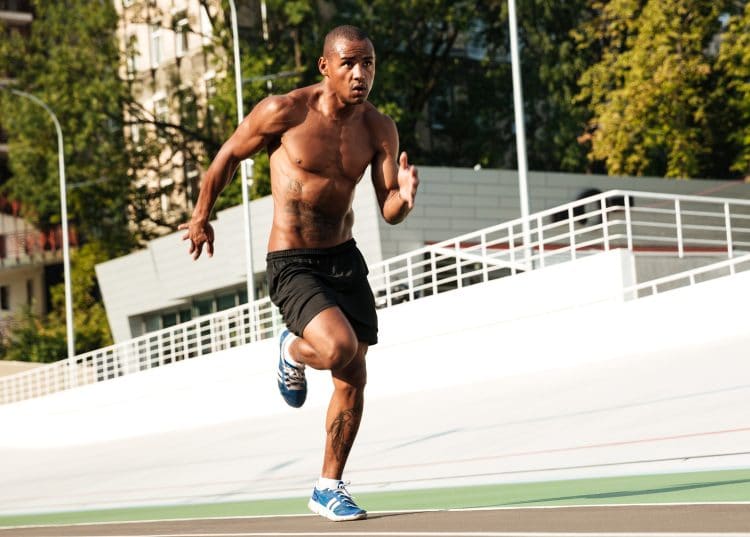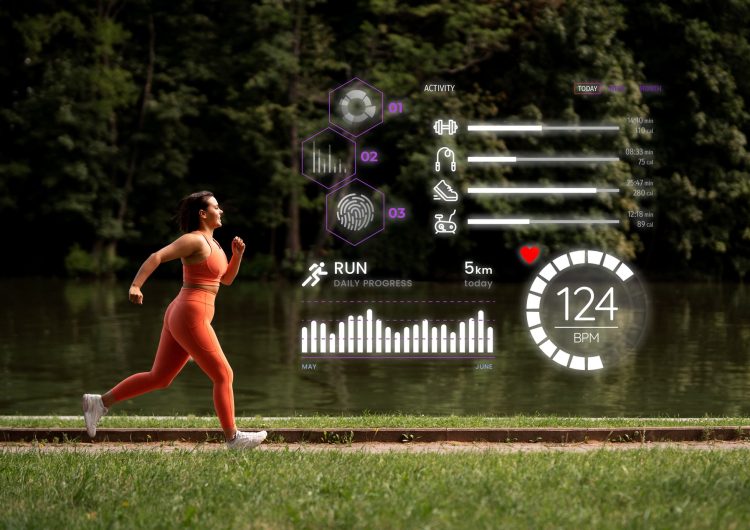Weight loss is one of the most common reasons why people join a gym. However, most quit before achieving their objectives.
As a veteran personal trainer, I can attest that most people make minimal progress even after weeks of hardcore training because they don’t fully understand the ins and outs of cardio training.
Cardio has a long list of benefits. It can help lose weight, boost energy levels and cognitive function, improve heart health, mood, and sleep quality, lower blood pressure, and strengthen immune function. (1)
However, if it’s not done strategically, cardio can actually work against your fitness goals.
In this article, I reveal 10 hidden truths about cardio that will help you optimize your progress. So, sit tight and read on.
1. Cardio Doesn’t Automatically Equal Fat Loss
Level Up Your Fitness: Join our 💪 strong community in Fitness Volt Newsletter. Get daily inspiration, expert-backed workouts, nutrition tips, the latest in strength sports, and the support you need to reach your goals. Subscribe for free!
Many people spend up to an hour on cardio equipment daily in hopes of losing weight. However, they balance it out by eating junk food. Weight loss comes from a simple equation — you must burn more calories than you eat.
“The most important factor for fat loss is a caloric deficit, which means burning more calories than you consume,” said Dr. Layne Norton (Ph.D. in Nutritional Sciences). “Cardio exercise can be a supplement to a caloric deficit to help you lose fat faster.”
Cardio is an incredible weight loss tool. However, it is not the be-all and end-all many people think it is. To lose weight, you must follow a balanced diet and training program that results in an overall calorie deficit.
Determine your target TDEE with this online calculator and use a balanced macro split to work toward your dream physique.
2. It’s Not All About the Treadmill
The treadmill is easily the most popular cardio equipment. However, using it daily can make things monotonous and lead to a loss of motivation. I have my personal training clients switch cardio equipment every few days to keep things exciting. Rowing, biking, and stairmills are some of the other classics.
That said, you don’t have to limit yourself to the gym. Swimming, dancing, and playing sports are excellent cardio activities that will help you burn calories and enter a deficit. Pick activities based on your fitness levels. For example, people with joint issues can prefer swimming.
I recommend using your rest days to get outdoors and try some fun activities like hiking, kayaking, or paintball. Find things that you can stick to for the long term.
3. Cardio Can Build Muscle, Too
Done right, cardio can support your muscle-building ambitions.
High-intensity interval training (HIIT) involves short bursts of all-out effort followed by brief recovery periods that push the body to its anaerobic limits. This type of training can trigger adaptations that boost muscle growth and burn calories.
The great thing about HIIT workouts is that you can choose between lower-body and full-body exercises based on your training objectives.
I recommend inclined treadmill walks, runs, or uphill sprints to push the lactic acid into your wheels and kickstart metabolic adaptations that can translate to stronger and jacked glutes, quads, hamstrings, and calves.
While you shouldn’t expect to add inches to your thighs through HIIT cardio alone, you can certainly build stronger and a more defined physique, which can give an illusion of bigger muscles. You can use the newly unlocked strength to lift heavier in the gym to promote hypertrophy.
Strategic programming is key here. Riding the elliptical will probably not get you strong and muscular legs. Also, extended cardio sessions can put you in a catabolic state, where your body burns muscle tissue for energy.
4. The Importance of Rest and Recovery
Going harder, faster, and longer isn’t guaranteed to help you lose weight. However, they increase the chances of burnout and injury. You must give your body the downtime it needs to recuperate.
The ideal rest time can vary for each individual based on their training intensity, duration, recovery potential, and age.
Ensure that you get between eight and nine hours of eye shut time each night and eat a balanced diet to optimize recovery. Sports massages or self-myofascial release are good ideas to boost the recovery process.
5. Your “Cardio Zone” Isn’t All It’s Cracked Up To Be
Most cardio equipment has this convenient heart rate chart plastered on it. It basically tells you that staying in a particular heart rate zone will make your body burn more fat. Heart rate zone training is an oversimplified concept.
Again, while training in a particular zone can prioritize aerobic endurance or anaerobic capacity, it won’t necessarily help burn body fat. Maintaining a calorie deficit is your best bet to losing the spare tire.
Level Up Your Fitness: Join our 💪 strong community in Fitness Volt Newsletter. Get daily inspiration, expert-backed workouts, nutrition tips, the latest in strength sports, and the support you need to reach your goals. Subscribe for free!
That said, high-intensity exercise does push your metabolism into overdrive. The afterburn effect, also known as excess post-exercise oxygen consumption (EPOC), helps you burn calories even hours after your training session.
6. It’s Not One-Size-Fits-All
You need a tailored fitness program to lose weight. What works for your gym buddy might not work for you. Beginners might see quick results by maintaining a calorie deficit for a few weeks. However, people stuck on a plateau might need to rework their strategy completely.
“The amount of cardio you should do depends on your individual goals and time constraints. For example, if you have a significant amount of body fat to lose, you may need to do more cardio than someone who is just looking to maintain their weight,” said Norton.
Furthermore, your training program should be designed around your fitness levels. Consider any injuries and health conditions that you are dealing with. Beginners should work with a personal trainer to design a personalized training program that can help them achieve specific goals.
7. More Isn’t Always Better
“Doing too much cardio can lead to fatigue, which can cause you to become less active throughout the day. This can negate the calorie-burning effects of cardio,” said Dr. Mike Israetel (Ph.D. in Sports Physiology)
A meta-analysis of 21 studies published in the Journal of Strength and Conditioning Research concluded that while some cardio is beneficial, excessive concurrent cardio and strength training can limit muscle and strength gains. (2)
Feel free to take a day off if you feel overly sore or burnt out. Pushing through chronic fatigue increases your risk of injury. Learn to listen to your body, and you’ll be rewarded with faster results.
8. Cardio’s Impact on Mental Health
Cardio’s physical benefits are well-known. However, it also has several mental health advantages.
Physical activity helps lower cortisol levels, the body’s primary stress hormone. It also releases endorphins, which help relieve pain, reduce stress, and improve one’s sense of well-being. Even if one starts their workout feeling stressed, they’ll likely leave feeling refreshed.
High-intensity interval training (HIIT) increases cortisol and corticosterone levels, which then decrease below baseline levels and return to baseline after 24 hours. Moderate-intensity cardio sessions have similar effects on circulating cortisol levels. (3)
However, a study published in the Journal of Endocrinological Investigation found that regular, long-term, low-intensity cardio training can reduce circulating cortisol levels. (4)
Meditation and journaling are other effective ways of lowering anxiety. I recommend consulting a healthcare professional if these practices don’t deliver relief.
9. Don’t Be Afraid of Intensity

As a personal trainer, I see people stick to the same training intensity for an extended period, which can lead to plateaus. Cranking up the training intensity can help break through the overhead ceiling by boosting calorie expenditure and pushing you out of your comfort zone.
HIIT workouts are also usually shorter than lower-intensity sessions, which can save you a ton of time. High-intensity training can also boost your work capacity, making your regular workouts and day-to-day activities feel easier.
However, you should start slow and increase the training intensity and frequency as you get more comfortable. Focus on your form as you push yourself harder, as poor mechanics and movement patterns can lead to strains.
Pay attention to your body’s signals and adjust your training intensity accordingly.
10. Making Cardio Work for You
Cardio isn’t limited to running, swimming, or biking. For long-term adherence, you must find out what suits your fitness levels and goals and stick to it for the long term.
Something as simple as daily walks can get you to your fitness objectives.
A 2023 meta-analysis found that a 1,000-step increment correlated with a significant reduction of all-cause mortality of 15%, and similarly, a 500-step increment correlated with a reduced risk of CV mortality of 7%. (5)
Plan your workouts in advance and treat them like important appointments that you cannot afford to miss.
I also recommend investing in tools that can help you track progress.
A smartwatch can help monitor your daily activity and ensure you burn enough calories throughout the day to achieve your fitness goals. Remember, you don’t have to get the latest and the greatest fitness trackers to monitor your progress. An entry-level fitness band like a Fitbit Inspire would do the trick.
Norton recommends scheduling your cardio on days that you don’t have resistance training workouts. This is because cardio can interfere with your recovery from resistance training. However, if you cannot perform cardio and resistance training workouts on separate days, you can still do them back-to-back. Just ensure you do your resistance training first, followed by cardio.
Conclusion
Cardio’s benefits extend beyond fat loss and can lead to improved mental health and help tone the body. However, overdoing cardio can backfire by hindering recovery and muscle growth. Constantly monitor your body’s signals to maximize your performance while limiting the risk of burnout.
If you have any questions about cardio training, drop them in the comments below, and I’ll be happy to help!
References
- Mersy D. J. (1991). Health benefits of aerobic exercise. Postgraduate Medicine, 90(1), 103–112.
- Wilson, J. M., Marin, P. J., Rhea, M. R., Wilson, S. M., Loenneke, J. P., & Anderson, J. C. (2012). Concurrent training: a meta-analysis examining interference of aerobic and resistance exercises. Journal of strength and conditioning research, 26(8), 2293–2307.
- Sun, L., Li, F. H., Li, T., Min, Z., Yang, L. D., Gao, H. E., Wu, D. S., & Xie, T. (2020). Effects of high-intensity interval training on adipose tissue lipolysis, inflammation, and metabolomics in aged rats. Pflugers Archiv : European journal of physiology, 472(2), 245–258.
- Hill, E. E., Zack, E., Battaglini, C., Viru, M., Viru, A., & Hackney, A. C. (2008). Exercise and circulating cortisol levels: the intensity threshold effect. Journal of Endocrinological Investigation, 31(7), 587–591.
- Banach, M., Lewek, J., Surma, S., Penson, P. E., Sahebkar, A., Martin, S. S., Bajraktari, G., Henein, M. Y., Reiner, Ž., Bielecka-Dąbrowa, A., & Bytyçi, I. (2023). The association between daily step count and all-cause and cardiovascular mortality: a meta-analysis. European journal of preventive cardiology, 30(18), 1975–1985.












